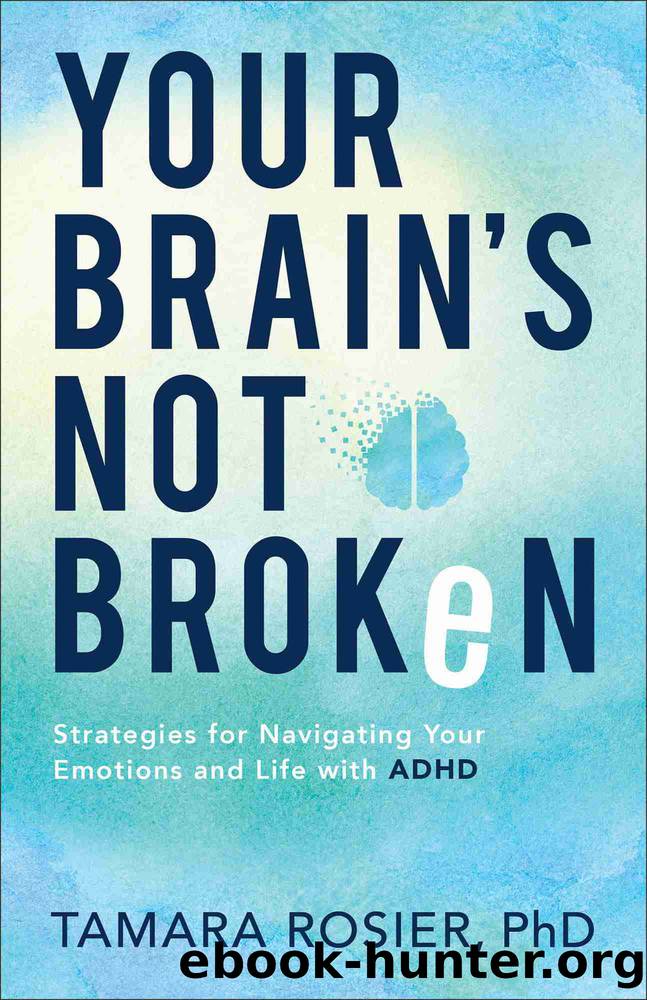Your Brainâs Not Broken by Tamara Phd Rosier

Author:Tamara Phd Rosier
Language: eng
Format: azw3
Tags: Self-Help, Attention-deficit disorder in adults, REL012030, Attention-deficit hyperactivity disorder, PSY022010, Attention-deficit disorder in adolescence, FAM047000
ISBN: 9780800739423
Publisher: Revell
Published: 2021-09-21T00:00:00+00:00
Curious and Shiny
Here is an unconscious principle those with ADHD live by: Fun things get my attention, and therefore fun tasks get done. We are captivated by excitement and amusement, so our brains search the horizon for the interesting, the shiny, the curious, the remarkable, the excitingâand call it all âfun.â This principle affects our levels of drive, our motivation, our happiness, and even our sense of well-being.
Though researchers think that several parts of the brain may be associated with the symptoms of ADHD, one area is particularly interesting when we are talking about the idea of fun. Right in the center of the brain is a part called the striatum. Known as the pleasure center of the brain, the striatum helps evaluate whether something is good and then allows us to experience joy and happiness. It is also able to learn to predict when rewards are coming.
Researchers wanted to find out if the striatum works differently in people who have ADHD. College students were shown a series of images as they lay in an MRI machine so that researchers could observe the active parts of the brain that lit up. The screen repeatedly showed the students a square shape and a diamond shape. After the diamond shape, sometimes a glass jar with coins appeared. The students were told that they would get some money on a gift card each time they saw the coins. But every time after the square shape was shown, a big X on the glass jar would appear, showing that they wouldnât get any money that time. As the college students saw different shapes and outcomes, researchers could see where their brains became more active.
Most people would start liking the diamond better than the square, right? They would begin to get excited when they saw a diamond because they knew what was coming nextâa monetary reward. That seems logical, doesnât it? And that is how it played out for the students who did not have ADHD. The striatum lit up (became more active) when they saw the diamond shape and waited for the image of the coins to appear. It was anticipating the cue that âgood things are coming soon!â
An interesting thing happened, however, when researchers viewed the scans of the students who had ADHD. Their striata didnât light up as much when they saw the diamond shape, even though it preceded the coin image indicating a reward would be coming soon. The striata in these brains didnât become active until the students actually saw the jar with coins. The striata of those with ADHD responded most when they actually received the reward, not while they were waiting for the reward.
The subjects in this study reacting to the actual rewards instead of the rewards coming in the future shows that the ADHD brain apparently lacks predictive abilities. Ugh. Thatâs a problem for us as we attempt to begin a task. Without those brain signals in the striatum telling us that good things are coming and
Download
This site does not store any files on its server. We only index and link to content provided by other sites. Please contact the content providers to delete copyright contents if any and email us, we'll remove relevant links or contents immediately.
Should I Stay or Should I Go? by Ramani Durvasula(6839)
Why We Sleep: Unlocking the Power of Sleep and Dreams by Matthew Walker(5689)
Fear by Osho(4114)
Flow by Mihaly Csikszentmihalyi(4086)
Why We Sleep by Matthew Walker(3807)
Rising Strong by Brene Brown(3804)
Too Much and Not the Mood by Durga Chew-Bose(3716)
How to Change Your Mind by Michael Pollan(3704)
The Hacking of the American Mind by Robert H. Lustig(3608)
Lost Connections by Johann Hari(3474)
He's Just Not That Into You by Greg Behrendt & Liz Tuccillo(3333)
Evolve Your Brain by Joe Dispenza(3076)
What If This Were Enough? by Heather Havrilesky(2957)
Resisting Happiness by Matthew Kelly(2907)
Crazy Is My Superpower by A.J. Mendez Brooks(2885)
The Courage to Be Disliked by Ichiro Kishimi & Fumitake Koga(2829)
The Book of Human Emotions by Tiffany Watt Smith(2794)
Descartes' Error by Antonio Damasio(2765)
In Cold Blood by Truman Capote(2708)
